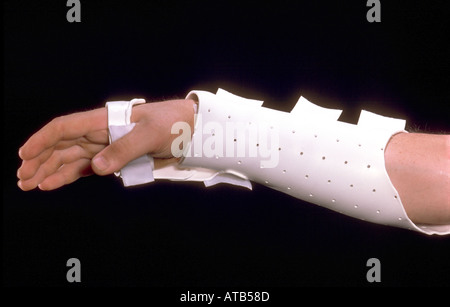


To avoid contractures at the wrist joint and refrain from developing a large immobile and motion restricting scar, the scar tissue surrounding the site of surgery should be mobilised often. Range of motion exercises are also important for scar management after surgery.
#Colles fracture splint position free#
Range of motion exercises will help to regain free movement at the wrist joint but will also help to decrease oedema or swelling, and pain. To begin with, an occupational therapist will look at moving the wrist through extension and flexion exercises within the individuals pain free limits and their current range. Occupational Therapists are experts in hands on treatment to get rid of muscle spasming and tightness caused by surgery.ĭuring the early stages of rehabilitation, the main goal is to return range of motion of the wrist to its normal limits by conducting passive range of motion exercises initially and then moving on to active range of motion exercises. In this case, when the wrist joint is compromised, such as during healing or immediately after injury, the muscles of the wrist will tighten and may form tight, ropey bands of muscle fibres, or knots of tension in the muscle causing pain, which are known as trigger points. When there is any trauma through any joint in the body, the normal response the body will provide, as a protective measure, is to contract the muscles to protect the surrounding structures. How Does an Occupational Therapist Treat a Colles Fracture?Ī Soft Tissue Occupational Therapist is a musculoskeletal therapist who treats soft tissue conditions, including complications of the muscles, tendons and ligaments of the body. This is generally done at the 7-8 week point but if the fracture was managed with an internal fixation, may occur as early as 1 week after surgery. Once the bone has healed after surgery, the primary goal of rehabilitation is to get the wrist moving and regain range of motion. The surgical treatment of a Colles fracture is either an internal or external fixation in which the bone is held together by means of plate and screws allowing the bone to heal in its correct and desired position. This is where a doctor will move the bone to its correct position and cast, without a surgical incision being made. In some cases, if the bone is close to its normal position, a technique known as closed reduction will be performed. Your doctor may refer for an X-ray to assess bone healing. A more severe fracture will result in more regular check-ups. If the wrist and hand is likely to still be used, such as in a young person, or an athlete, a plaster cast will be used for roughly 6 weeks with regular check-ups from a doctor to keep an eye on the healing process. A splint may be considered over a cast if you are less active, as more active people are at risk of re-injury in a splint. If the bone is still within its regular alignment, a cast or splint may be used to set the bone in place to heal in its regular alignment. Non-surgical treatment of a Colles fracture will occur if the fracture is less severe and not very painful. After the fracture is allowed to heal, which will generally take six weeks, sometimes shorter in young adults and longer in older adults who naturally have slower healing timeframes, rehabilitation will begin. They will also likely have a decrease in their functional abilities. Surgical and Non-surgical Treatment of a Colles Fracture:Ī person with a Colles fracture will usually have pain, oedema, and decreased range of motion and strength. Other ways an individual who has had a Colles fracture would present are as: having a history of a fall onto an outstretched hand, having swelling in the wrist or pain local to the wrist, a decreased ability to grasp and pick up objects, numbness, tenderness, bruising, or an angled deformity of the wrist. The straight forearm, angled wrist, and curved hand, together form the image of a fork. It is described this way because when fractured, the distal part of the radius moves upward creating an angle in the forearm near the wrist. The deformity which results from the Colles fracture is referred to as “having a dinner fork presentation”. This fracture causes the radius to move upward to create an obvious and prominent deformity. It is more commonly found in older populations due to poor bone health, which leaves them more susceptible to breaks, but can also result from high impact collisions in sports which cause athletes to land on the hand and forearm. This kind of fracture results from an individual falling on to their outstretched hand. A Colles fracture occurs on the distal part of the radius, the larger of two bones in the forearm.


 0 kommentar(er)
0 kommentar(er)
